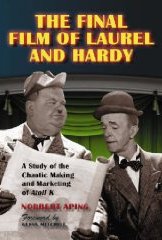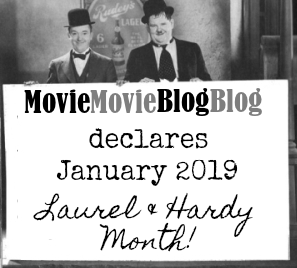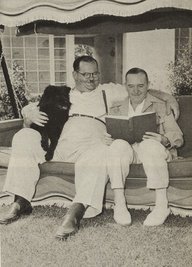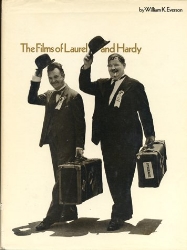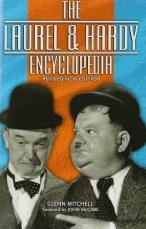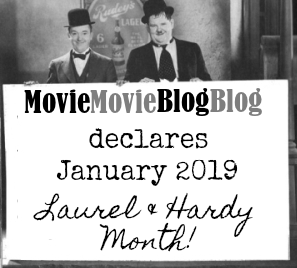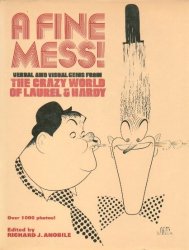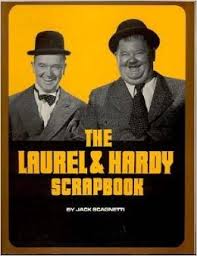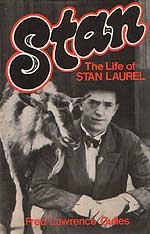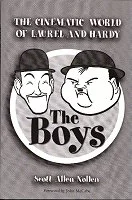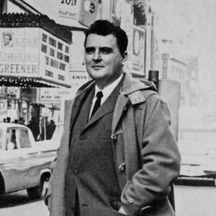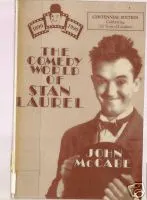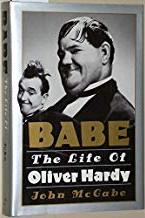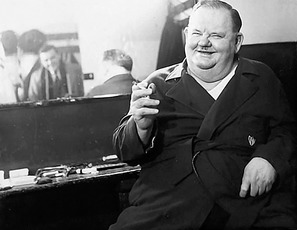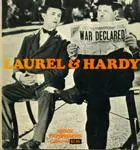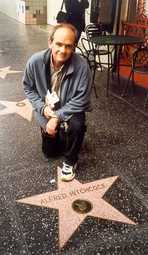
The following list is today’s contribution to this blog’s self-designated Laurel & Hardy Month. What on Earth does that mean? Click on the above image to find out!

While I don’t expect the following list to have any significance beyond this blog, one can’t help noticing countless recurring themes and ideas in Laurel & Hardy movies. So I’ve made a list of such themes as they’ve turned up in more than one movie — everything from hostile wives to gorillas. Enjoy!
*
A
Academy Award:
– Meanest Hal Roach Studios veteran to be nominated for an: L&H budget-cutter Henry Ginsberg, for co-producing the movie Giant (see below)
– Nicest Hal Roach Studios veteran to be nominated for an: composer Marvin Hatley, nominated for his scores for Way Out West and Block-Heads
– Nicest Hal Roach Studios veteran to win an: George Stevens (early L&H cinematographer, who won the Best Director Oscar for Giant)
– L&H films nominated for an: The Hollywood Revue of 1929 (Best Picture), The Music Box (Best Short Subject), Tit for Tat (Best Short Subject), Way Out West (Best Musical Score), Block-Heads (Best Musical Score)
– L&H films winning an: The Music Box (Best Short Subject) [Stan Laurel himself was awarded an honorary Oscar in 1960]
Ad-libs, repeated (proving that just repeating them doesn’t make them any funnier): “Will you stop crowding?” (Ollie, Berth Marks, while trying to undress with Stan in an upper berth), “What are you gonna do?” (James Finlayson, Way Out West, while he is clearly being tied to a chandelier)
Airplanes, runaway, containing Stan and Ollie: The Flying Deuces, The Big Noise
Amputations, faked/mistaken: Pack Up Your Troubles, Block-Heads
Amusement parks: Sugar Daddies, On the Loose, The Dancing Masters
Animals not listed elsewhere on this page: Liberty (crab), The Chimp (fleas), The Flying Deuces (shark), Atoll K (pet lobster)
Apples: Call of the Cuckoos, Do Detectives Think?, Sons of the Desert (wax)
Artists: Slipping Wives, The Fixer-Uppers, The Flying Deuces
Auctions: One Good Turn, Thicker Than Water, The Dancing Masters
Automobiles:
– damaged/destroyed by/with Stan and Ollie: Leave ’em Laughing, Two Tars, Hog Wild, The Stolen Jools, Our Wife, One Good Turn, County Hospital, The Midnight Patrol, Towed in a Hole, Busy Bodies, Block-Heads, Saps at Sea, Great Guns (Jeep), Air Raid Wardens, The Dancing Masters (bus), The Bullfighters (taxi door)
– Ollie almost run over by: The Perfect Day, Hog Wild, Below Zero, Any Old Port, Jitterbugs
– Sunk in mud puddles: Leave ’em Laughing, The Perfect Day
B
Banana peels: The Battle of the Century, From Soup to Nuts, A Chump at Oxford, The Dancing Masters
Bathtubs/bathing: Slipping Wives, Call of the Cuckoos, Brats, Be Big, Come Clean, Dirty Work, Them Thar Hills
Bats: The Laurel-Hardy Murder Case, Atoll K
Beans: Them Thar Hills, Block-Heads
Bears: Flying Elephants, The Rogue Song
Billiards/pool: Brats, Any Old Port
Birds: The Finishing Touch, The Rogue Song (chicken), Towed in a Hole (duck), Dirty Work (shot out of the air), The Flying Deuces, Great Guns (crow)
Blackmail: Sugar Daddies, Love ’em and Weep, Chickens Come Home, The Bullfighters
Block-and-tackle: The Music Box, Way Out West
Boat, Laurel & Hardy on a: Why Girls Love Sailors, Sailors, Beware!, Men o’ War, Towed in a Hole, Sons of the Desert (alibi), The Live Ghost, Our Relations, Saps at Sea, Jitterbugs, Atoll K
Boxing: The Battle of the Century, Brats, Any Old Port
Break-ins/burglaries: Habeas Corpus, Night Owls, Scram!, The Midnight Patrol, Way Out West
Brooklyn Bridge, the: Pack Up Your Troubles (seen in opening titles), Way Out West (dialogue reference), Jitterbugs (stock footage, allegedly of New Orleans but really New York)
Bulls: Fra Diavolo, The Bullfighters
Buses, double-decker: Putting Pants on Philip, Hog Wild, The Dancing Masters
C
Cake accidents: From Soup to Nuts, The Hollywood Revue of 1929, Our Wife, Twice Two, Our Relations
Cameo appearances: Call of the Cuckoos, The Stolen Jools, On the Loose, Wild Poses, Hollywood Party, On the Wrong Trek, Pick a Star
Cannibalism: March of the Wooden Soldiers (Stan and Ollie eating the supposed remains of their pig friend Elmer)
Care-givers (Stan and Ollie): Brats, Pack Up Your Troubles, Their First Mistake, The Bohemian Girl, Great Guns, Nothing But Trouble
Cats: Night Owls, March of the Wooden Soldiers, Atoll K
Character actors, villainous (Hal Roach stock company): Mae Busch, Rychard Cramer, James Finlayson, Anita Garvin, Charlie Hall, Walter Long (shown at right), Charles Middleton, Blanche Payson, Tiny Sandford
Checkers: Brats, The Live Ghost
Cheese: The Rogue Song, Swiss Miss
Cherries: The Second Hundred Years, From Soup to Nuts, Men O’War (soda)
Children, bratty: Block-Heads, The Big Noise
Children, bratty, played by Stan and Ollie: Brats, Wild Poses
Chimneys, Ollie falling down: Hog Wild, Dirty Work
Cigars: Their Purple Moment, Big Business, Their First Mistake, Busy Bodies, Way Out West, Swiss Miss, The Flying Deuces
Cities, name-checked: Philadelphia, Pennsylvania (That’s My Wife); Pottsville, Pennysylvania (Berth Marks); Poughkeepsie, New Jersey (Pack Up Your Troubles); Jesup, Georgia (Dirty Work); Chicago, Illinois and Honolulu, Hawaii (Sons of the Desert); Atlanta, Georgia (The Fixer-Uppers); Pellore, India (Bonnie Scotland); London, England (Way Out West); Des Moines, Iowa (The Flying Deuces); Dayton, Ohio and Milledgeville, Georgia [Hardy’s real-life hometown] (A-Haunting We Will Go); Madison, Wisconsin and Pearl Harbor, Hawaii (The Tree in a Test Tube); New Orleans, Louisiana (Jitterbugs); Peoria, Illinois (The Bullfighters)
Climaxes, special-effects, cheesy: County Hospital, The Dancing Masters
Coffee: Below Zero, One Good Turn, Pack Up Your Troubles, Them Thar Hills, Swiss Miss, Great Guns
Cooks/chefs: From Soup to Nuts, Their Purple Moment, Pack Up Your Troubles, Bonnie Scotland (Stan, improvising), Swiss Miss, Great Guns, Nothing But Trouble (Ollie), Atoll K
Courtrooms: Scram!, Going Bye-Bye, The Bullfighters
D
Dancing: That’s My Wife, The Music Box, The Chimp, Scram!, Bonnie Scotland, Way Out West, The Flying Deuces, Jitterbugs, The Dancing Masters
Dentists: Leave ’em Laughing, Pardon Us, The Dancing Masters
Dishwashing: Helpmates, Thicker Than Water, Swiss Miss, Nothing But Trouble
“Dixie,” heard in: The Music Box, Bonnie Scotland, The Bullfighters
Doctors: County Hospital, Them Thar Hills, Sons of the Desert (veterinarian), Thicker Than Water, Saps at Sea, Great Guns
Dogs: The Lucky Dog, Sugar Daddies, From Soup to Nuts, Early to Bed, Bacon Grabbers, The Perfect Day, Pardon Us, Laughing Gravy, Swiss Miss, The Dancing Masters
Dream-motif finales: The Laurel-Hardy Murder Case, Oliver the Eighth
Drunks, non-Stan and Ollie: You’re Darn Tootin’, Scram!, Our Relations, The Big Noise
Drunk scenes (L&H):
– Stan and Ollie: Blotto, Scram!, Them Thar Hills, The Fixer-Uppers
– Stan only: Fra Diavolo, The Bohemian Girl, Swiss Miss, A Chump at Oxford, The Bullfighters
– Ollie only: Early to Bed
Dual roles: Brats, Twice Two, Our Relations, The Bullfighters (Stan only)
Ducks: Towed in a Hole, Dirty Work
E
Egg-breaking: The Hollywood Revue of 1929, Hollywood Party, The Live Ghost, Tit for Tat, The Bullfighters
Employment agencies: From Soup to Nuts, Double Whoopee, A Chump at Oxford, Nothing But Trouble
Executions, attempted, of Stan and Ollie: Fra Diavolo, Bonnie Scotland, The Flying Deuces, Atoll K
F
Fake money, Stan and Ollie duped by: Hollywood Party, Swiss Miss, A-Haunting We Will Go
Feathers: March of the Wooden Soldiers, Swiss Miss, Great Guns, The Dancing Masters (feather duster)
Female form, observation of the: Hats Off, Putting Pants on Philip (Stan), From Soup to Nuts (Ollie), Hog Wild (Stan)
Female impersonations (Stan): Duck Soup, Why Girls Love Sailors, That’s My Wife, Another Nice Mess, A Chump at Oxford, Jitterbugs
Female impersonations, two persons dressed as one woman: Sugar Daddies, Chickens Come Home
Fertilizer: Beau Hunks, Chickens Come Home, Air Raid Wardens
Films:
– Color (not colorized): The Rogue Song, The Tree in a Test Tube
– “First” (shorts that were, for various reasons, cited as Laurel & Hardy’s “official” first film): The Lucky Dog, Duck Soup, Putting Pants on Philip
– Missing: Now I’ll Tell One (first half), Hats Off, The Battle of the Century (middle portion), The Rogue Song
– With four-letter words: The Perfect Day, Pardon Us
– With future famous actors/actresses: Sailors, Beware! (Lupe Velez), Bacon Grabbers and Double Whoopee (Jean Harlow), The Hollywood Revue of 1929 (Jack Benny), A Chump at Oxford (Peter Cushing), Great Guns (Alan Ladd), Jitterbugs (Vivian Blaine), The Dancing Masters (Robert Mitchum)
Film titles, recycled: Their First Mistake (originally the working title for Pardon Us), Jitterbugs (originally the working title for Saps at Sea)
Fire: Pardon Us (alternate ending), One Good Turn, Helpmates
Fish: Towed in a Hole (referenced in song by Ollie), Dirty Work, Bonnie Scotland, The Big Noise
Flirting, unrequited (Ollie): Sailors, Beware!, Putting Pants on Philip, Way Out West, The Flying Deuces
Flour: Helpmates, Great Guns, Atoll K
Food fights: Their Purple Moment, The Battle of the Century, The Hoose-Gow
Foods, inedible, eaten by Stan and Ollie: wax apple (Stan only, Sons of the Desert), invisible soup and water (Oliver the Eighth), flower (Stan only, Thicker Than Water), hat (Way Out West), “synthetic” meal (Saps at Sea), food “capsules” (The Big Noise), invisible drink (Stan only, Atoll K)
Freak endings: (Click here to see our blog’s entry about this topic)
Freak endings administered by Walter Long: Going Bye-Bye, The Live Ghost
G
Games:
– Finger- , mastered only by Stan: Fra Diavolo, The Bohemian Girl
– Not listed elsewhere on this page: dice (Sailors, Beware!), jigsaw puzzle (Me and My Pal), pee-wees (March of the Wooden Soldiers)
Garbage/trash cans: Night Owls, Pack Up Your Troubles, Bonnie Scotland
Ghosts: The Live Ghost, A Chump at Oxford
Goats: Flying Elephants, Angora Love, Saps at Sea
Gorillas: The Chimp, Swiss Miss
Gout: The Perfect Day, Them Thar Hills
H
Hangovers: Sugar Daddies, Helpmates
Harlow, Jean (photo only): Brats, Beau Hunks
Hat, Ollie’s, as a source of gags: Hog Wild, Be Big, The Music Box, Way Out West
Hat-blowing trick (Stan): Towed in a Hole, Bonnie Scotland
High-and-mighty (dangerous height) scenes: Liberty, Hog Wild, County Hospital, Busy Bodies, The Flying Deuces, Saps at Sea, Nothing But Trouble
Hitch-hiking: On the Wrong Trek, Way Out West
Homosexuality, latent (themes): Liberty, Their First Mistake, Jitterbugs
Horse costume (Stan and Ollie): Another Fine Mess, The Chimp
Horses, actual: Wrong Again, The Rogue Song, The Music Box, Fra Diavolo, Way Out West, Great Guns (See also Reincarnations, animal [Ollie])
Hospitals: County Hospital, Thicker Than Water, The Dancing Masters
I
Ice cream: Men o’ War, Come Clean, Twice Two
Inheritances: Early to Bed, That’s My Wife, The Laurel-Hardy Murder Case, Laughing Gravy (alternate ending), Way Out West
Insects: With Love and Hisses (bees), The Rogue Song (flies), Our Wife (flies), The Chimp (fleas), Bonnie Scotland (hornets)
Instruments, run over: You’re Darn Tootin’, Below Zero
J
Jail/prison: The Second Hundred Years, The Hoose-Gow, Pardon Us, Pack Up Your Troubles (Army guardhouse), Bonnie Scotland, Our Relations, The Flying Deuces, Saps at Sea, A-Haunting We Will Go (first scene), Nothing But Trouble
Jewelry: locket (Bohemian Girl, Way Out West), ring (Our Relations, The Flying Deuces)
K
Kennedy, Edgar, as a cop: The Finishing Touch, Leave ’em Laughing, Unaccustomed as We Are, Night Owls
Kiss, Stan overwhelmed by a: The Fixer-Uppers, The Bullfighters
Kitchens, exploding: Unaccustomed As We Are, Helpmates, Block-Heads, Saps at Sea
L
Landlords/landladies, hostile: Leave ’em Laughing, You’re Darn Tootin’, Early to Bed (if you count Ollie as the “landlord”), They Go Boom, Angora Love, Laughing Gravy, The Chimp, Fra Diavolo, March of the Wooden Soldiers, Thicker than Water, Bonnie Scotland, The Dancing Masters
Laughing scenes (Stan and Ollie): Leave ’em Laughing, Blotto, Scram!, Fra Diavolo, Way Out West (Stan only), Great Guns
Laundry: Helpmates, One Good Turn, Bonnie Scotland, Way Out West, The Flying Deuces
Laurel & Hardy as “themselves”: Pick a Star, The Tree in a Test Tube
Lawyers: Bonnie Scotland, Atoll K
Lawyers played by Stan: Sugar Daddies, Now I’ll Tell One
Laurel & Hardy-impersonation films, ill-advised: Another Nice Mess, The New Adventures of Laurel & Hardy: For Love or Mummy
Legal issues: Pack Up Your Troubles, Their First Mistake, Our Relations, Way Out West
Lingerie displayed by L&H co-stars:
– Harlow, Jean: Double Whoopee (at right)
– Todd, Thelma: Unaccustomed as We Are, On the Loose
Lions: The Chimp, Hollywood Party, A-Haunting We Will Go, Nothing But Trouble, Atoll K
Lockets: The Bohemian Girl, Way Out West
Lodges: Sons of the Desert, Our Relations
M
Magic acts: The Hollywood Revue of 1929, A-Haunting We Will Go
Magic, “white” (Stan doing impossible things): Way Out West, Block-Heads, Great Guns, A-Haunting We Will Go, Atoll K
Marriages, attempted: Sugar Daddies, Our Wife, Pack Up Your Troubles, Any Old Port, Me and My Pal, March of the Wooden Soldiers
Marshmallows: Brats, Tit for Tat
Mice: Brats, March of the Wooden Soldiers
Military: With Love and Hisses, Two Tars, Men o’ War, Beau Hunks, Pack Up Your Troubles, Bonnie Scotland, Block-Heads, The Flying Deuces, Great Guns
Milk: Their First Mistake, Wild Poses, Going Bye-Bye, The Flying Deuces
Mirrors: Hog Wild (Ollie), Helpmates (Ollie), Their First Mistake (Stan), Great Guns (Stan)
Monkeys: The Chimp, Dirty Work, Swiss Miss
Mortality: The Midnight Patrol, The Live Ghost, The Flying Deuces
Musical numbers (Stan and Ollie): Brats, Pardon Us, Way Out West, Swiss Miss, The Flying Deuces
Musicians (Stan and Ollie): You’re Darn Tootin’, Berth Marks, Below Zero, Our Relations (Stan on horn), Pick a Star, Swiss Miss, The Flying Deuces (Stan on bedsprings), Saps at Sea (Stan on horn), Jitterbugs
N
Nudity, near-: With Love and Hisses (Stan and Ollie), Call of the Cuckoos (Max Davidson), Double Whoopee (Jean Harlow)
O
Ocean liners, fictional: Sailors Beware, Putting Pants on Philip (S.S. Miramar), Sons of the Desert (S.S. Luwanna and S.S. Meewana, Honolulu Steamship Company)
Ocean liners, real: Blockheads (RMS Mauretainia, Cunard Line), A Chump at Oxford (RMS Queen Mary, Cunard Line), Nothing But Trouble (S.S. Ile de France, French Line)
Ollie:
– As an upper-class citizen: Early to Bed, Chickens Come Home, Me and My Pal
– As a pawn in a jealousy plot: The Fixer-Uppers, Swiss Miss
– Getting married: Our Wife, Me and My Pal, Oliver the Eighth
– In politics: mayoral candidate (Chickens Come Home), island president (Atoll K)
P
Paint, wet: Habeas Corpus, The Second Hundred Years, The Hoose-Gow, Towed in a Hole, March of the Wooden Soldiers, The Big Noise
Parades, Stan and Ollie in: Beau Hunks, Pack Up Your Troubles, Sons of the Desert, Bonnie Scotland, The Flying Deuces, Great Guns
Pens, malfunctioning: The Battle of the Century, Double Whoopee, Chickens Come Home (dry), Any Old Port, The Music Box, The Flying Deuces (dry)
Phone conversations (Stan and Ollie): Blotto, Chickens Come Home, Helpmates, Twice Two, The Fixer-Uppers
Phone numbers (Stan): Blotto, Helpmates, Beau Hunks [Trivia: Stan Laurel used his current, real-life phone number in these movies]
Photographers, professional: The Battle of the Century, The Stolen Jools, Pardon Us, Wild Poses, Hollywood Party, Block-Heads, A Chump at Oxford
Pianos: Wrong Again, Big Business, Night Owls, Another Fine Mess, Beau Hunks, The Music Box, Way Out West, Swiss Miss
Pies: The Battle of the Century, Their Purple Moment
Poetry, written by Stan and recited by Ollie: The Fixer-Uppers, Swiss Miss
Policemen, Laurel & Hardy as: Now I’ll Tell One (Hardy only), The Midnight Patrol
Policemen, Stan and Ollie’s encounters with: Duck Soup, Sugar Daddies, The Second Hundred Years, Putting Pants on Philip, The Finishing Touch, You’re Darn Tootin’, Two Tars, Big Business, Liberty, Double Whoopee, Unaccustomed as We Are, They Go Boom, Bacon Grabbers, The Hoose-Gow, Night Owls, Below Zero, The Laurel-Hardy Murder Case, Another Fine Mess, The Music Box, Pack Up Your Troubles, Me and My Pal, Sons of the Desert, Tit for Tat, Our Relations, Way Out West (Western sheriff), Saps at Sea, A-Haunting We Will Go, The Big Noise
Process-servers: Bacon Grabbers, Their First Mistake
Professors, pretentious: Prof. Padilla (Habeas Corpus), Prof. Theodore von Schwarzenhoffen, M.D., A.D., D.D.S., F.L.D., F. F. F. and F. (The Music Box), Prof. Noodle (Dirty Work), Lord Paddington (A Chump at Oxford), Prof. Fendash Gorp (The Dancing Masters)
Prohibition: Blotto, Pardon Us
Punch-and-Judy show (puppet show referenced as a favorite entertainment of Stan and Ollie’s): Their First Mistake, Our Relations
R
Rabies, mistaken cases of: Early to Bed, The Dancing Masters
Radios: Bacon Grabbers, Hog Wild, Come Clean, Me and My Pal
Rain: The Laurel-Hardy Murder Case, Helpmates, Scram!, Sons of the Desert, Atoll K
Ration coupons: Jitterbugs, Nothing But Trouble
Reading glasses: Going Bye-Bye, Our Relations
Records, phonograph: Should Married Men Go Home?, We Faw Down, Liberty, Unaccustomed as We Are
Reincarnations, animal (Ollie): Dirty Work (chimp), The Flying Deuces (horse)
Relatives:
– Non-wife: Ollie’s uncle (That’s My Wife and The Perfect Day), Stan and Ollie’s sons (Brats), Stan’s uncle (Laughing Gravy, alternate ending), Stan and Ollie’s sisters (Twice Two), Ollie’s brother-in-law (Sons of the Desert), Ollie’s mother & Stan and Ollie’s twin brothers (Our Relations)
– Stories about (Stan): The Laurel-Hardy Murder Case, One Good Turn, Beau Hunks
Remakes (and their predecessors): Another Fine Mess (Duck Soup), Laughing Gravy (Angora Love), The Music Box (Hats Off), The Fixer-Uppers (Love ’em and Weep), The Flying Deuces (Beau Hunks)
Retribution (Stan towards Ollie): Early to Bed, One Good Turn, A Chump at Oxford
Rifles/shotguns: Slipping Wives, Liberty, Bacon Grabbers, We Faw Down, Wrong Again, The Hoose-Gow, Be Big, Blotto, Pack Up Your Troubles, Dirty Work, Sons of the Desert, Oliver the Eighth, Way Out West, Block-Heads
Roach family, Hal, cameo appearances: Hal Roach in Pardon Us (in front of Ollie in line, after Ollie’s re-capture); Hal’s daughter Margaret, in A-Haunting We Will Go (walk-on role; billed as Diane Rochelle)
Robberies, attempted by Stan and Ollie: Night Owls, Fra Diavolo, The Bohemian Girl
S
Safes: The Midnight Patrol, Way Out West, The Dancing Masters
Salesmen: Hats Off, Big Business, The Fixer-Uppers, Swiss Miss
Sand: The Second Hundred Years, Beau Hunks, Block-Heads
Servants/waiters (Stan and Ollie): Slipping Wives (Ollie only), Sugar Daddies (Ollie only), From Soup to Nuts, Early to Bed (Stan only), Another Fine Mess (Stan only, disguise), A Chump at Oxford, Great Guns, Nothing But Trouble
Shakespeare, William: Hollywood Revue of 1929(non-Laurel and Hardy portion has scene from “Romeo and Juliet”), Pardon Us (bust), The Music Box (bust), Pack Up Your Troubles (bust), Me and My Pal (bust), Tit for Tat (quoted), Our Relations (dialogue reference; also, plot is loosely based on “The Comedy of Errors”)
Shanghai-ing: Sailors, Beware!, The Live Ghost
Shaving: The Rogue Song, Busy Bodies, Oliver the Eighth, Great Guns
Signing the register: Double Whoopee, Any Old Port, Air Raid Wardens, The Bullfighters
Silent-comedy legends who contributed to L&H movies: Harry Langdon (co-wrote the screenplays for Block-Heads, The Flying Deuces, A Chump at Oxford, and Saps at Sea), Buster Keaton (contributed uncredited gags for Nothing But Trouble)
Slot machines: Men o’ War, Way Out West
Snow: Below Zero, The Rogue Song, Laughing Gravy, The Fixer-Uppers
Soda-fountain cashiers (“Soda jerks”): Should Married Men Go Home?, Men o’ War, Come Clean, Twice Two, Tit for Tat
Soup: From Soup to Nuts, You’re Darn Tootin’, That’s My Wife, The Hoose-Gow, One Good Turn, Twice Two, Oliver the Eighth (“invisible” soup), Nothing But Trouble, Atoll K
Sports, non-boxing: golf (Should Married Men Go Home?), football (Nothing But Trouble)
Stan Laurel Productions: Our Relations, Way Out West
Steaks: Their Purple Moment, Below Zero, Any Old Port, Nothing But Trouble
Streetcars: The Lucky Dog, Hog Wild, Tit for Tat (sarcastic reference)
Stomach, expanding: They Go Boom (Ollie), Below Zero (Stan), Be Big (Ollie), Pick a Star (Ollie)
T
Taxidermy: Another Fine Mess, Block-Heads, Fra Diavolo
Taxis: Sailors, Beware!, Their Purple Moment, Liberty, Double Whoopee, Me and My Pal, Sons of the Desert, The Bullfighters
Telegrams: Blotto, Laughing Gravy, Helpmates, Me and My Pal, Great Guns
“Tell me that again” (Ollie’s request that Stan repeat his initially brilliant idea, at which point Stan garbles it): Towed in a Hole, Oliver the Eighth, The Fixer-Uppers, The Dancing Masters
Thieves (Stan and Ollie): The Lucky Dog (Ollie only), Fra Diavolo, The Bohemian Girl
Town gossip, the: Their Purple Moment, Chickens Come Home
Trains: With Love and Hisses, Berth Marks, Be Big, A-Haunting We Will Go, The Big Noise
Tunneling as a means of escape: The Second Hundred Years, The Flying Deuces
V
Vacuum cleaners: The Dancing Masters, The Big Noise
Venice, Italy, painting of: We Faw Down, Unaccustomed As We Are, Brats, Another Fine Mess, Saps at Sea
W
Water:
– Fountains: Early to Bed, The Bullfighters
– Ollie dunked in: Dirty Work, March of the Wooden Soldiers, The Midnight Patrol, Bonnie Scotland, Way Out West
– Stan dunked in: Below Zero
– Stan and Ollie dunked in: Brats, Hog Wild, Our Relations, Jitterbugs
– Thrown: Sailors, Beware!, Angora Love, Hog Wild, Laughing Gravy, Helpmates, Towed in a Hole, Swiss Miss, Block-Heads (on Ollie, from a hose), The Bullfighters
Wives, hostile: Their Purple Moment, We Faw Down, Blotto (Stan only), Be Big, Chickens Come Home, Come Clean, Helpmates (Ollie only), Sons of the Desert, Thicker Than Water (Ollie only), Block-Heads (Ollie only)
World War I: Pack Up Your Troubles, Block-Heads
